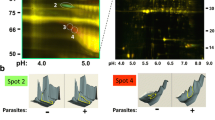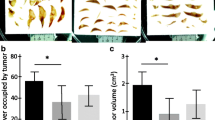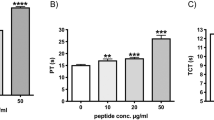Abstract
We have recently found presence of a high concentration of a novel type of kinin, hydroxyprolyl3-bradykinin (Hyp3-BK) in human tumor ascites in addition to conventional bradykinin (BK). Because of their potential physiological activity, it is of interest to know how these bradykinins can be degraded in ascites. Degradation of two synthetic kinins, BK and Hyp3-BK, added to the ascitic fluid from patients with ovarian carcinoma and hepatoma, were analyzed by reversed phase HPLC. Both kinins were degraded into their desArg9-BK or-Hyp3-BK and desPhe8-Arg-9-BK or-Hyp3-BK products following incubation with the ascitic fluid. The rate of the degradation of BK and Hyp3-BK was the same. The formation of desArg9-BK was completely inhibited by kininase I inhibitor, while the formation of desPhe8-Arg9-BK was not completely inhibited by a kininase II inhibitor. The degradation of both kinins was inhibited completely by EDTA. The results indicate the presence of other metalloprotease(s) which cleaves kinins in the ascitic fluid, in addition to kininase I and kininase II. The carboxypeptidase A and carboxypeptidase B inhibitor, benzyl malic acid, failed to block degradation of both kinins. A rapid cleave of Phe-Arg into Phe and Arg was also found in the ascitic fluid. Thus, the major degradation products of kinins in the ascitic fluid were demonstrated to be either desArg9-BK or Hyp3-BK, desPhe8-Arg9-BK or-Hyp3-BK, phenylalanine and arginine. Lysyl-BK and lysylhydroxyprolyl3-BK were rapidly converted into BK and hydroxyprolyl3-BK by the ascitic fluid.
Similar content being viewed by others
Abbreviations
- BK:
-
Bradykinin
- Hyp3-BK:
-
Hydroxyprolyl3-bradykinin
- CPNI:
-
carboxypeptidase N inhibitor
- APMSF:
-
para-amidinophenylmethylsulfonyl fluoride
References
H. I. Peterson and K. L. Appelgren,Experimental studies on the uptake and retention of labelled proteins in a rat. Europ. J. Cancer9, 543–947 (1972).
K. Iwai, H. Maeda and T. Konno,Use of oily contrast medium for selective drug targeting to tumor enhanced therapeutic effect and X-ray image. Cancer Res.44, 2115–2121 (1984).
H. Maeda, T. Matsumoto, T. Konno, K. Iwai, and M. Ueda,Tailormaking of protein drugs by polymer conjugation for tumor targeting: a brief review of smancs. J. Protein Chem.3, 181–193 (1984).
Y. Matsumura and H. Maeda,A new concept for macromolecular therapeutics in cancer chemotherapy: mechanism of tumoritropic accumulation of proteins and the antitumor agent smancs. Cancer Res.46, 6387–6392 (1986).
D. R. Senger, S. J. Galli, A. M. Dvorak, C. A. Peruzzi, V. S. Harvey and H. F. Dvorak,Tumor cells secrete a vascular permeability factor that promotes accumulation of ascites fluid. Science (Was. DC)219, 983–985 (1983).
Y. Matsumura, M. Kimura, T. Yamamoto and H. Maeda,Involvement of the kinin generating cascade in tumor tissue. Jpn. J. Cancer Res.79, 1372–1374 (1988).
Y. Matsumura, K. Kimura, H. Kato, T. Yamamoto and H. Maeda,Quantification, isolation and structural determination of bradykinin and hydroxyprolyl 3-bradykinin in tumor ascites. inKinins V. (Ed. H. Moriya) Plenum Publishing New York (in press).
H. Maeda, Y. Matsumura and H. Kato,Purification and identification of hydroxyprolyl 3-bradykinin in ascites fluid from a patient with gastric cancer. J. Biol. Chem.236, 16051–16051 (1988).
M. Sasaguri, M. Ikeda, M. Ideishi and K. Arakawa,Identification of [hydroxyproline 3 ]-lysyl-bradykinin released from human plasma protein by kallikrein. Biochem. Biophys. Res. Commun.150, 511–516 (1988).
H. Kato, Y. Matsumura and H. Maeda,Isolation and identification of hydroxyproline analogues of bradykinin in human urine. FEBS Lett.232, 252–254 (1988).
M. Maier, G. Reissert, I. Jerabek, F. Lottspeich and B. R. Binder,Identification of [hydroxyproline 3 ]-lysyl-bradykinin released from human kininogens by human urinary kallikrein. FEBS Lett232, 395–398 (1988).
T. Mindroiu, O. A. Carretero, D. Proud, D. Walz and A. G. Scicli,A new kinin moiety in human plasma kininogens. Biochem. Biophys. Res. Commun.152, 519–526 (1988).
J. Inokuchi and A. Nagamatsu,Tripeptidyl carboxypeptidase activity of kininase II (angiotensin-converting enzyme). Biochim. Biophys. Acta662, 300–307 (1981).
I. A. Sheikh and A. P. Kaplan,Studies of the digestion of bradykinin, Lys-bradykinin, and des-Arg 9-bradykinin by angiotensin converting enzyme. Biochem. Pharm.35, 1951–1956 (1986).
I. A. Sheikh and A. P. Kaplan,Studies of the digestion of bradykinin, lysyl-bradykinin, and kinin-degradation products by carboxypeptidases A, B, and N. Biochem. Pharm.35, 1957–1963 (1986).
M. Majima, A. Ueno, A. Sunahara and M. Katori,Detection of des-Phe 8 -Arg 9-bradykinin by enzyme immunoassay: A useful marker of release of plasma kinin. InKinins V. (Ed. H. Moriya) Plenum Publishing, New York (in press).
M. A. Ondetti, B. Rubin and D. W. Cushman,Design of specific inhibitors of angiotensin-converting enzyme: new class of orally active antihypertensive agents. Science196, 441–444 (1977).
T. H. Plummer Jr., and T. J. Ryan,A potent mercapto by product analogue. Biochem. Biophys. Res. Commun.98, 448–454 (1981).
T. Tanaka, H. Suda, H. Naganawa, M. Hamada, T. Takeuchi, T. Aoyagi and H. Umezawa,Production of (S)-α-benzylmalic acid, inhibitor of carboxypeptidase A by actinomycetes. J. Antibiot.37, 682–683 (1984).
D. W. Cushman, H. S. Cheung, E. F. Sabo and M. A. Ondetti,Design of potent competitive inhibitors of angiotensin-converting enzyme. Carboxyalkanoyl and mercaptoalkanoyl amino acids. Biochemistry16, 5484–5491 (1977).
I. A. Sheikh and A. P. Kaplan,Mechanism of digestion of bradykinin and lysylbradykinin (kallidin) in human serum; Role of carboxypeptidase, angiotensin-converting enzyme and determination of final degradation products. Biochem. Pharm.38, 993–1000 (1989).
Author information
Authors and Affiliations
Rights and permissions
About this article
Cite this article
Matsumura, Y., Maeda, H. & Kato, H. Degradation pathway of kinins in tumor ascites and inhibition by kininase inhibitors: Analysis by HPLC. Agents and Actions 29, 172–180 (1990). https://doi.org/10.1007/BF01966443
Received:
Accepted:
Issue Date:
DOI: https://doi.org/10.1007/BF01966443




